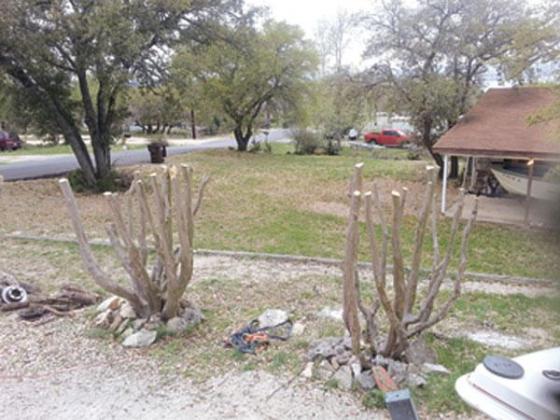
Dan Gill/LSU AgCenter Horticulturist
“A tree which has lost its head will never recover it again, and will survive only as a monument of the ignorance and folly of its tormentor.” George William Curtis, American writer, editor and speaker
“Crape murder” is the term that has been coined to describe severely cutting back crape myrtle trees. Although perhaps a little overly dramatic, it is in use by horticulturist across the Southeast wherever crape myrtles are a popular and common tree.
I often encounter gardeners who’ve somehow gotten the idea that they are supposed to prune crape myrtles that way. This is often from seeing crape myrtles that have been treated this way. But this is absolutely incorrect. Cutting back crape myrtle trees is not, and never has been, the preferred way of handling these graceful and beautiful trees. In addition, it is not healthy for the trees in the long run. Cutting back crape myrtles creates large wounds that can serve as points of entry for fungal decay organisms. Pruning like this shortens the life of the tree. One way to stop a practice is to debunk the reasons why it is done.
Pruning misconceptions
Belief: This is the preferred or best way to prune a crape myrtle.
Truth: Nothing could be farther from the truth. For the overwhelming majority of us, enhancing the natural shape of our crape myrtles is most appropriate.
Belief: Crape myrtles bloom better when cut back.
Truth: This is not accurate. The flower clusters may be larger on severely pruned trees. But the added weight on the ends of long, thin branches causes them to bend over awkwardly, especially after a rain. These low-hanging flower heads can create problems and get in the way when a crape myrtle is planted near a driveway, sidewalk or path. And because the tree is smaller, it actually produces fewer flower clusters.
Belief: You can cut back a crape myrtle to change its shape.
Truth: Some types of crape myrtles grow tall and upright like a vase, while others are shorter and spreading, more like a mushroom. These shapes are controlled by genetics. You cannot make an upright-growing crape myrtle grow in the shape of a mushroom by cutting it back. An upright-growing variety will simply grow back upright again. So if you want a crape myrtle that will mature the shape you desire, make sure you choose one that naturally grows that way.
Belief: Young crape myrtles should be cut back to make them look “fuller.”
Truth: Young trees often appear spindlier and less substantial than older, well-established trees. But this is a matter of age, not something that needs to be corrected with pruning. Young crape myrtles are not supposed to look like older crape myrtles. Over time, young trees will attain the shapely, full canopies of older trees without drastic pruning.
Belief: You should cut back a crape myrtle to control its size.
Truth: If the height of the crape myrtle is not causing a problem with a nearby structure or power lines, there is little reason to reduce a tree’s height. To cut a crape myrtle back for the vague reason of “it just seems too large” ignores the fact that these plants are trees. They are supposed to be relatively large. Nobody cuts back other flowering trees just because they dared to grow into what they are – small trees. Why do we do it to crape myrtles?
Prune properly
To prune a crape myrtle properly, first decide if it needs to be pruned at all. As with any pruning project, you must have a specific, valid purpose in mind before you begin. In other words, if you can’t come up with a good reason to prune your tree, leave it alone.
If you do see something that calls for pruning, study the tree carefully and determine what needs to be removed to accomplish the specific purpose. If the problem is one branch is touching the edge of the roof, deal with that branch. Don’t cut back the whole tree.
Every crape myrtle will need some pruning in its life to grow properly and fit in well with its surroundings. Here are some examples:
– Over time, branches that are too low on the trunk(s) will need to be removed to raise the canopy to the desired height. We often need to remove weak, thin or vertical shoots from the inner part of the tree to produce a cleaner-looking plant.
– Selected branches may need to be pruned back to a side branch or the trunk to create a shapelier tree and to eliminate crossed and rubbing branches. Generally, avoid cutting back or shortening branches much larger than your finger, although cutting larger branches back to a side branch or to the trunk when needed is fine.
– Of course, you need to prune to keep suckers removed from the base of the trunk. This is especially important in younger trees.
– You may also need to redirect a branch’s growth. This can be done by studying the branch carefully and looking for a side branch that grows in the desired direction. Prune the branch of interest back to that branch, and you have redirected the growth of the branch. This can be helpful where trees are too close to a structure, such as a house. A common problem is crape myrtle trees being planted too close to a house; they should be located at least 10 feet away from the house roof line. In situations where trees are close to a house and branches are hitting the roof, branches can be redirected to grow away from or up and over the roof line by using this pruning technique.
